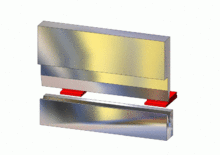plate
Sheet metal is a flat metal plate, i.e. a flat plate, the thickness of which is an order of magnitude smaller than its other dimensions. Sheet metal is a material used as a semi-finished product for engineering and construction production. Sheet metal is most often produced by hot and cold rolling, but it can also be produced by casting, forging or pulling. The most used is steel sheet, but sheets of other metal materials are also produced, e.g. aluminum, copper, brass, etc. The main parameter defining sheet metal is its thickness. The sheet thickness is normalized. Sheets thinner than approx. 0.1 mm are called metal foils, sheets thicker than approx. 15 mm are called metal plates.
Shaped plate
Sheet metal is produced not only as flat plates, but also shaped (profiled). Profiling increases the strength of the sheet against bending (the plate is self-supporting) and can be used directly as a construction element.
Normalization
Sheet metal is produced in the form of plates, strips or in the form of sheet metal coils (rolls).
Sheets are divided according to thickness into:
thin t ≤ 2.99 mm
average thickness 4.75 mm >= t ≥ 3.00 mm
thick t ≥ 4.76 mm
Sheet metal plate formats are standardized for further processing. Sheet metal cut to a defined format is called sheet metal.
small size (normal): 1000×2000 mm
medium format: 1,250×2,500 mm
large format: 1,500×3,000 mm
Standardized ISO dimensions:
2000 x 6000 / 8000 / 12000 mm
2500 x 6000 / 8000 / 12000 mm
3000 x 6000 / 8000 / 12000 mm
3,500 x 7,000 / 14,000 mm
4000 x 12000 / 16000 mm
Steel plate

Sheet metal bending
Steel sheet is a versatile material, used mainly for the production of machine bodies, most often cars. It is relatively easy to shape, sufficiently strong and durable. The disadvantage is that steel is easily subject to corrosion, therefore raw steel sheet is used only in non-corrosive environments. The sheet metal is protected with a protective coating of paint or a plastic coating, or a protective metal layer. The sheet metal is plated with metals more resistant to corrosion, e.g. zinc, tin, nickel, chromium, etc. The surface layer is applied by heat or electrolytically. Copper, brass, aluminum, titanium sheets are resistant to the standard corrosive (external) environment. The sheet metal is further processed by pressing, punching, cutting, bending and tinkering technologies.
Galvanized sheet
Galvanized sheet metal is one of the most commonly used surface treated sheets. Zinc forms an electrical cell with iron in steel, in which only the corrosion of the zinc layer occurs.
Tinned sheet
It is mainly used in the food industry, because tin and its alloys are not poisonous to humans and do not dissolve in organic acids contained in food.
Copper plate
It is mainly used for the production of roofs due to its exceptional resistance to carbonic acid (rain). It forms a thin layer of oxides on the surface, which is resistant to further corrosion. The only problem is the copper-steel combination, which creates electrochemical cells that promote corrosion.
Aluminum sheet
It is mainly used in the aviation industry because it is lighter than steel sheet with the same strength. Aircraft fuselages are made from it. It welds poorly, so it is mainly riveted.

